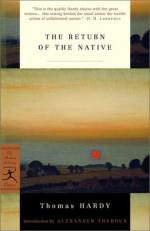His theory and his wishes about devoting his future to teaching had made an impression on Mrs. Yeobright. Indeed, how could it be otherwise when he was a part of her—when their discourses were as if carried on between the right and the left hands of the same body? He had despaired of reaching her by argument; and it was almost as a discovery to him that he could reach her by a magnetism which was as superior to words as words are to yells.
Strangely enough he began to feel now that it would not be so hard to persuade her who was his best friend that comparative poverty was essentially the higher course for him, as to reconcile to his feelings the act of persuading her. From every provident point of view his mother was so undoubtedly right, that he was not without a sickness of heart in finding he could shake her.
She had a singular insight into life, considering that she had never mixed with it. There are instances of persons who, without clear ideas of the things they criticize, have yet had clear ideas of the relations of those things. Blacklock, a poet blind from his birth, could describe visual objects with accuracy; Professor Sanderson, who was also blind, gave excellent lectures on colour, and taught others the theory of ideas which they had and he had not. In the social sphere these gifted ones are mostly women; they can watch a world which they never saw, and estimate forces of which they have only heard. We call it intuition.
What was the great world to Mrs. Yeobright? A multitude whose tendencies could be perceived, though not its essences. Communities were seen by her as from a distance; she saw them as we see the throngs which cover the canvases of Sallaert, Van Alsloot, and others of that school—vast masses of beings, jostling, zigzagging, and processioning in definite directions, but whose features are indistinguishable by the very comprehensiveness of the view.
One could see that, as far as it had gone, her life was very complete on its reflective side. The philosophy of her nature, and its limitation by circumstances, was almost written in her movements. They had a majestic foundation, though they were far from being majestic; and they had a groundwork of assurance, but they were not assured. As her once elastic walk had become deadened by time, so had her natural pride of life been hindered in its blooming by her necessities.
The next slight touch in the shaping of Clym’s destiny occurred a few days after. A barrow was opened on the heath, and Yeobright attended the operation, remaining away from his study during several hours. In the afternoon Christian returned from a journey in the same direction, and Mrs. Yeobright questioned him.
“They have dug a hole, and they have found things like flowerpots upside down, Mis’ess Yeobright; and inside these be real charnel bones. They have carried ’em off to men’s houses; but I shouldn’t like to sleep where they will bide. Dead folks have been known to come and claim their own. Mr. Yeobright had got one pot of the bones, and was going to bring ’em home—real skellington bones—but ’twas ordered otherwise. You’ll be relieved to hear that he gave away his pot and all, on second thoughts; and a blessed thing for ye, Mis’ess Yeobright, considering the wind o’ nights.”




